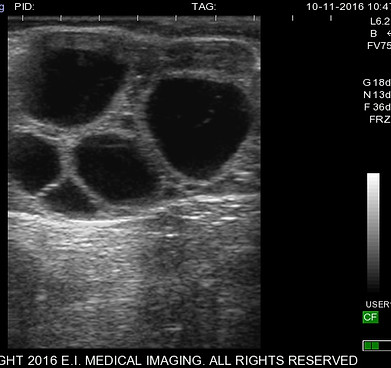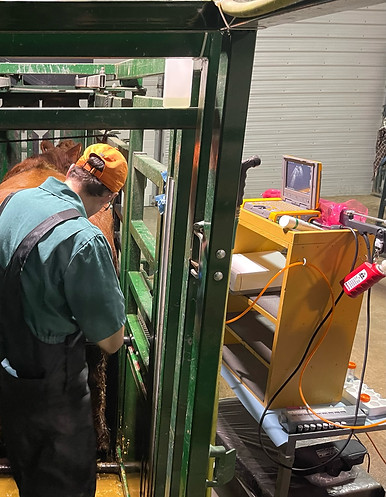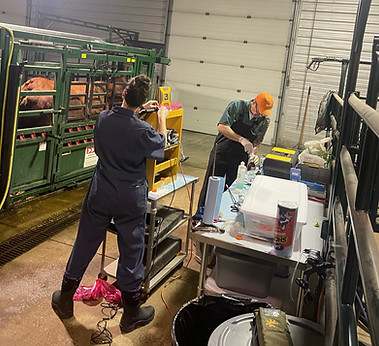Cattle Embryo Transplants, In-Vivo, IVF and International Embryo Sales
IN-VITRO FERTILIZATION (IVF)

* 1 straw of semen can fertilize several donors
* Average 10 – 15 eggs per collection. About 70% of these will be fertilized
45 - 55% will become a viable and freezable
* Pregnancy rate with IVF embryos = Average 45 - 60% (depending on fresh or frozen implant)
* Collection of donors every 2 weeks
Donors can be collected pregnant up to 120 days of pregnancy
* Can collect heifers either before or after breeding
* If conventional flushing not working, IVF may be a viable option to produce good embryos

A growing number of cattle breeders are using In-Vitro Fertilization (IVF) to maximize embryo production from donors that need to be pregnant, problem cows, young heifers and better use of expensive or rare semen.
This is the process of harvesting oocytes (eggs) from donor cow’s ovaries, and creating embryos by fertilizing the oocytes with semen in a petri dish.
The embryo is then implanted into a recipient cow (surrogate cow), or they can be frozen indefinitely.
COLLECTIONS
IVF is a proven technique with sound conception rates when performed correctly, conventional ET is less expensive than IVF. However, that is changing, as IVF costs are decreasing with different lab methods. With conventional in-vivo flushing, a donor female needs to be kept open to be bred and flushed, and cows can be collected at minimum intervals of 30 - 45 days.
Collections every two weeks are possible with IVF, as the eggs are collected directly off the ovaries, not from the uterus. This also allows for collections from pregnant cows. After confirming by ultrasound that they’re 30 to 35 days in calf, the female receives the FHS super-stimulation drug to produce multiple follicles. The IVF veterinarian then uses an ultrasound-guided needle to aspirate the eggs off the ovaries. In the lab, eggs are matured and fertilized before being cultured for seven days.

HOW THE PROCEDURE WORKS

The first stage is a process called dominant follicle removal (DFR) this is done by ultra-sound guided trans-vaginal aspiration which removes the dominant follicle in the ovary, allowing the rest of the follicles to grow.
In a normal estrous cycle, the dominant follicle inhibits the growth of other follicles – otherwise a cow could end up developing dozens of follicles and end up with a pregnancy with multiple calves. With IVF, all follicles are left for six days to develop uninhibited within the ovary.
The next stage is OPU (ovum pick-up), this is performed 6 days post DFR. Eggs are collected from the donor cows ovary by ultra-sound guided trans-vaginal aspiration before the ovary naturally releases the egg down the fallopian tube.
THE 7 STEPS OF IVF
1. Dominant Follicle Removal (DFR)
DFR can be performed on-farm or at the Bova-Tech facility using an ultrasound-guided needle to remove the dominant follicle from the ovary.
2. Super-ovulation
A three-day course of follicle stimulating hormones (FSH) are administered to stimulate ovaries to produce more eggs.


3. Ovum pick-up (OPU)
The donor cow is brought into a temperature controlled collection facility. Oocytes/eggs are harvested via ultrasound guided trans-vaginal aspirations, averaging 10 - 15 eggs per collection depending on the donor cow, the eggs are then matured for 20-24 hours.
4. Incubator
Eggs are placed into insulated chambers (incubator) at around 38C to mimic a cow’s body temperature.
5. Fertilization
One straw of semen can be utilized to fertilize several eggs from different cows if necessary.
6. Embryos
Resulting embryos are matured for a week in the laboratory, passing through eight different maturation liquids (medias) mimicking the changing pH and gas levels inside the uterus.
7. Embryos can be transferred directly into recipient cows or frozen indefinitely

BENEFITS

Problem breeders can be salvaged because they can be used as a donor if, for example, they have:
-
Uterine damage
-
Fallopian tubes blocked
-
Scarring
Extend breeding life:
-
Collection possible from 10 months to 20 years old and above
-
Ovaries can be recovered from abattoir
Pregnant cows, young heifers and better use of expensive, rare or poor quality semen
